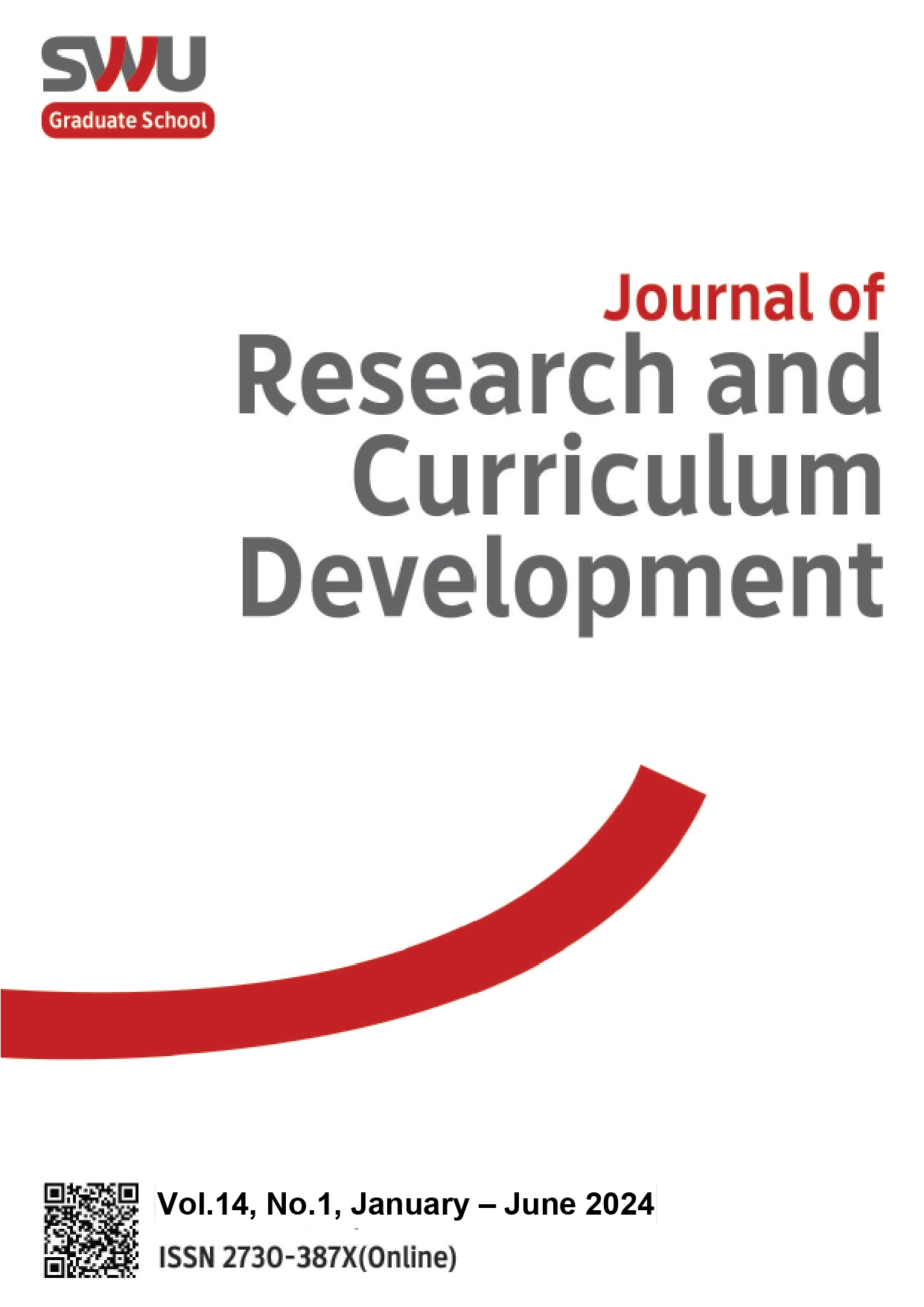Development of Mathematical Concepts about Statistics Using the Concept Formation Model together with Concept-Rich Instruction and Higher-Order Questions for Undergraduate Students Majoring in Mathematics
Keywords:
Concept formation model, Concept-rich instruction, Higher-order questions, Mathematical concepts, Mathematical misconceptions, StatisticsAbstract
The purposes of this research are as follows: (1) to compare and study mathematical concepts about statistics among undergraduate students majoring in mathematics before and after learning by using the concept formation model together with concept-rich instruction and higher-order questions; (2) to study mathematical misconceptions about statistics on undergraduate students majoring in mathematics; and (3) to study the opinions of undergraduate students majoring in mathematics about the use of the concept formation model together with concept-rich instruction and higher-order questions. The research samples were 35 undergraduate students in their second year of college and majoring in mathematics in the Faculty of Education of Burapha University. The research instruments were composed of six lesson plans using the concept formation model with concept-rich instruction and higher-order questions, a test of mathematical concepts about statistics, and the pre-learning and post-learning versions with a reliability of 0.78 and 0.855 respectively, and the record form of mathematical misconceptions about statistics and the questionnaire about opinions towards the use of concept formation model together with concept-rich instruction and higher-order questions. The overall research findings revealed the following: (1) the mathematical concepts about statistics of undergraduate students majoring in mathematics after learning by using the concept formation model together with concept-rich instruction and higher-order questions higher than before learning with a statistical significance level of .05; (2) the mathematical misconceptions about statistics of mathematics major undergraduates were three aspects as follows: problem interpretation, the use of theories, formulas, laws, definitions, properties and computations and (3) the opinions of undergraduate students majoring in mathematics about the use of the concept formation model together with concept-rich instruction and higher-order questions was in highest level (M=4.57, SD=0.51).
References
Angganapattarakajorn, V. (2012). What teacher of mathematics should know: Curriculum, instruction and research. Charansanitwong Printing.
Angganapattarakajorn, V. (2020). The study of mathematical concepts about statistics of students’ mathematics major undergraduate at faculty of education, Burapha University. Faculty of Education, Burapha University.
Ausubel, D. P. (1968). Educational psychology: A cognitive view. Rinehart & Winston.
Bureau of Educational Testing. (2022). Ordinary National Education Test Result Announcement. O-NET 2017-2021. https://www.niets.or.th.
Center of Teaching Excellence, University of Urbana Champaign. (2006). Effective classroom questioning. http://www.cte.uiuc.edu.
De Cecco, J. P. (1968). The psychology of learning and instruction: Educational psychology. Pentice-Hall.
Deogratias, E. (2020). Exploring the implementation of Concept-Rich Instruction (CRI) with university mathematics Pre-Service Teachers (PSTs): A Tanzanian case [Doctoral dissertation, University of Alberta]. https://doi.org/10.7939/r3-7feb-6g63.
Klausmeier, H. J. & Ripple, R. E. (1971). Learning and human abilities: Educational psychology. Harper International Editions.
Laphatpinyochok, P. (2015). Development of an instructional model to enhance concepts and mathematical processes for elementary students [Doctoral dissertation, Silpakorn University]. http://ithesis-ir.su.ac.th/dspace/handle/123456789/555.
Lasley, T. J., Matczynski, T. J. & Rowley, J. B. (2002). Instructional models: Strategies for teaching in a diverse society (2nd ed.). Wadsworth.
Li, X. (2003). Cognitive analysis of students’ errors and misconceptions in variables, equations and functions. ProQuest, UMI Dissertation Publishing.
Makanong, A. (2002). Mathematical knowledge of mathematics majors. Faculty of Education, Chulalongkorn University.
Makanong, A. (2009). Development of mathematics concept using the concept attainment model and higher-order questions. Faculty of Education, Chulalongkorn University.
Makanong, A. (2014). Mathematics for secondary school teachers. Chulalongkorn University Printing House.
McGillivrary, H. & Pereira-Mendoza, L. (2011). Teaching statistical thinking through investigative projects. In G. Burrill, C. Reading, & C. Batanero (Eds.) Teaching statistics in school mathematics–challenges for teaching and teacher education: A joint ICMI/IASE study: The 18th ICMI Study (pp. 109-120). Springer.
Meir Ben-Hur. (2006). Concept-rich mathematics instruction: Building a strong foundation for reasoning and problem solving. Association for Supervision and Curriculum Development.
Schmalz, R. (1978). Categorization of questions that mathematics teacher ask. Mathematics Teacher, 66(7), 619-626.
Srisuk, W. (2008). The development of instructional process integrating the concept formation model and the translation model to enhance mathematical knowledge and inductive thinking ability of lower secondary school students [Doctoral dissertation, Chulalongkorn University]. https://cuir.car.chula.ac.th/handle/123456789/21280.
The Institute for the Promotion of Teaching Science and Technology. (2012). Professional mathematics: The road to success. 3Q Media Co.,Ltd.
The Institute for the Promotion of Teaching Science and Technology. (2016). TIMSS 2015 Report. http://timssthailand.ipst.ac.th/timss/reports/timss2015report.
Thomas, R. & Josepha, R. (1998). Using questions to help children build mathematical power. Teaching Children Mathematics, 4(9), 504-509.
White, P. & Mitchelmore, M. C. (2002). Teaching and learning mathematics by abstraction. In D.O. Tall & M. Thomas (Eds.), Intelligence and Understanding in Mathematics (pp. 235-256). Post Pressed.
Downloads
Published
Issue
Section
License

This work is licensed under a Creative Commons Attribution-NonCommercial-NoDerivatives 4.0 International License.





